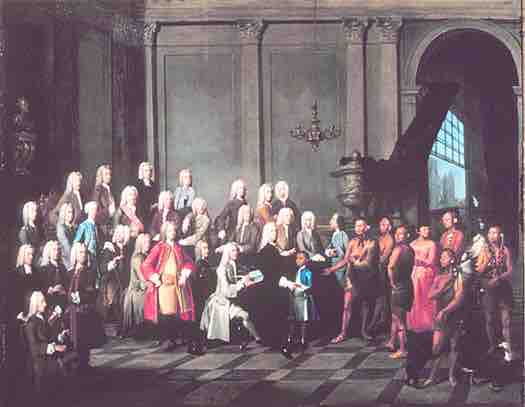From the 16th through the 19th centuries, the population of American Indians drastically declined due to epidemic diseases brought from Europe, genocide and warfare at the hands of Europeans, displacement from their lands, internal warfare, enslavement, and a high rate of intermarriage. After 1492, European exploration and colonization of the Americas revolutionized how the Old and New Worlds perceived themselves. With the meeting of the two worlds, animals, insects, plants, cultures, and diseases were carried from one to the other, both deliberately and by chance, in what is called the Columbian Exchange.
Conversion in the New World
The European colonists in North America often rationalized their expansion of their empire with the assumption that they were saving–as they perceived–a barbaric, pagan world by spreading Christian civilization. In the Spanish colonization of the Americas, the policy of Indian Reductions resulted in the forced conversions to Catholicism of the indigenous people. What developed during the colonial years and since, has been a syncretic Catholicism that absorbed and reflected indigenous beliefs.
The Spread of Diseases
Smallpox proved particularly fatal to American Indian populations. Epidemics often immediately followed European exploration and sometimes destroyed entire village populations. While precise figures are difficult to determine, some historians estimate that at least 30% (and sometimes 50% to 70%) of some American Indian populations died after first contact due to Eurasian smallpox.
In 1618–1619, smallpox killed 90% of the American Indians in the area of the Massachusetts Bay. Historians believe many Mohawk in present-day New York became infected after contact with children of Dutch traders in Albany in 1634. The disease swept through Mohawk villages, reaching the Onondaga at Lake Ontario by 1636, and the lands of the western Iroquois by 1679, as it was carried by Mohawk and other tribes who traveled the trading routes. The high rate of fatalities caused breakdowns in American Indian societies and disrupted generational exchanges of culture.
Smallpox epidemics in 1780–1782, and 1837–1838, brought devastation and drastic depopulation among the Plains Indians. By 1832, the federal government established a smallpox vaccination program for American Indians, known as the Indian Vaccination Act. It was the first federal program created to address a health issue among American Indians.
Exchange of Animals
Sheep, pigs, horses, and cattle were all Old World animals that were introduced to contemporary American Indians. In the 16th century, Spaniards and other Europeans brought horses to the Americas. The early American horse had been game for the earliest humans on the continent; it was hunted to extinction about 7000 BCE, just after the end of the last glacial period. The reintroduction of the horse to North America had a profound impact on the American Indian culture of the Great Plains. The tribes trained and used horses to ride, carry goods for exchange with neighboring tribes, hunt game, and conduct wars and raids. The people fully incorporated the use of horses into their societies and expanded their territories.
Slavery
When Europeans arrived as colonists in North America, many American Indian tribes began selling war captives to Europeans rather than integrating them into their own societies as they had done before. As the demand for labor in the West Indies grew with the cultivation of sugar cane, Europeans enslaved American Indians in the 13 North American colonies, and some were exported to the "sugar islands." The British settler-invaders, especially those in the southern colonies, purchased or captured American Indians to use as forced labor in cultivating tobacco, rice, and indigo. Accurate records of the numbers enslaved do not exist; scholars estimate tens of thousands of American Indians may have been enslaved by the Europeans.
The slave trade of American Indians lasted only until around 1730 and gave rise to a series of devastating wars among the tribes, including the Yamasee War. The Indian Wars of the early 18th century, combined with the increasing importation of African slaves, effectively ended the American Indian slave trade by 1750. Colonists found that American Indian slaves could easily escape, as they knew the country. The wars cost the lives of numerous colonial slave traders and disrupted their early societies. The remaining American Indian groups banded together to face the Europeans from a position of strength.

James Oglethorpe presenting the Yamacraw Indians to the Georgia Trustees
Yamacraw Creek Native Americans meet with the trustee of the colony of Georgia in England, in July 1734. The painting shows a Native American boy (in a blue coat) and woman (in a red dress) in European clothing.
In the 1790s, Benjamin Hawkins was assigned as the U.S. agent to the southeastern tribes that became known as the Five Civilized Tribes, for their adoption of numerous Anglo-European practices. Hawkins advised the tribes to take up slaveholding to aid them in European-style farming and plantations. He thought their traditional form of slavery, which had looser conditions, was less efficient than chattel slavery. In the 19th century, some members of these tribes began to purchase African American slaves.